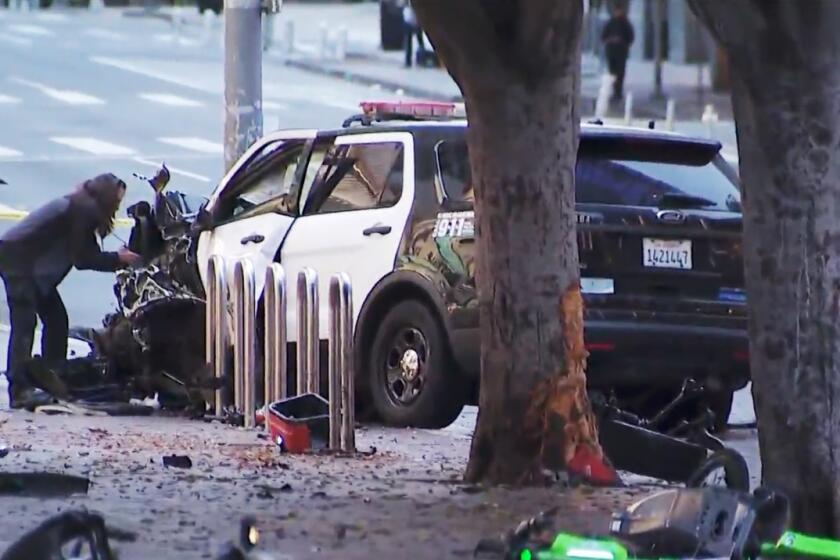Traditional ‘June Gloom’ Extends to July : Weather: Heavy smog days have been almost cut in half. Cool mornings are caused by global patterns also linked to Midwest rains.
The traditional “June Gloom” of chilly fog and clouds wrapping around the San Gabriel Mountains and the valley below has lingered into July, cutting the number of very unhealthy smog days almost in half, meteorologists and air quality experts say.
“It’s been overcast, cloudy and pretty dreary at times--but not smoggy,” said Joe Cassmassi, senior meteorologist with the South Coast Air Quality Management District.
“It’s been a unique year in that regard -- spring-like weather in the middle of July,” he said. Ironically, the relative lack of smog is caused by the same global weather conditions that are creating catastrophic flooding in the Midwest.
So far this year, nine first-stage smog alerts have been recorded throughout the Los Angeles Basin. Last year by this time, there had been 17.
Extensive morning cloudiness and fog have effectively blocked out the sunshine, thus delaying and inhibiting the formation of smog. Pollutants--hydrocarbons and nitrous oxides--react in the presence of sunlight to form smog.
During July, Cassmassi said, the average high temperatures in the San Gabriel Valley have dipped three to five degrees below the 87-91 range usually experienced at this time between Pasadena and Pomona.
This is a significant drop, he said. At the same time, winds coming from the Pacific Ocean also have been slightly stronger than normal for July.
Usually by this time of year, thermal inversions--a layer of warm air on top of cool marine air--clamp a lid 1,500 to 1,000 feet above sea level around the Los Angeles Basin, trapping the pollution below it. This is made worse by the emissions interacting with sunlight throughout the day.
These days, however, the lid is essentially nonexistent, said James McCutcheon, a meteorologist with WeatherData Inc., the private forecasting firm in Wichita, Kan., that supplies information for The Times.
This month, instead of a high-pressure system that sits over the San Gabriel Valley and forms an inversion, there has been an upper level, low-pressure system to foster cleaner air.
So the pollutants, blown about by the strong winds, mix freely throughout the lower levels of the atmosphere and are more easily diluted.
A first-stage alert is issued when smog levels exceed 200 on what is known as the Pollution Standard Index. At that point air is considered to be very unhealthful.
“The weather clearly has been more turbulent this summer than last, so the smog levels have not been building up to the high concentrations required to get a first-stage alert,” said AQMD spokesman Bill Kelly.
The number of first-stage alerts in Glendora, traditionally one of the smoggiest locations in the region and nation, dropped from 11 last year during the January-to-July period to 8 this year. In Pasadena, the number dropped from 6 to 2.
Since 1988 there have been no second-stage smog alerts, issued when the pollution level exceeds 275 on the Pollution Standard Index and the air is considered to hazardous.
But more moderate air pollution is still around. The number of days on which ozone levels exceeded federal standards--100 on the pollution index--rose to 72 so far this year compared with 68 during the same period last year.
The first half of June was cooler than normal, as was much of July. Most of the first-stage alerts this year occurred in the last half of June. At this time last year, the alerts were spread out over the period from April through July.
“Our benefit of a cooler summer,” Cassmassi said, has translated into a terribly rainy summer in the Midwest.
In part, meteorologists are blaming the rains on a combination of the weather forces resulting from a resurgent and persistent El Nino condition in the Pacific Ocean and a Bermuda High--a mass of air under unusually high pressure--from the Atlantic.
The El Nino is also helping to promote the low pressure over the California coast and the West Coast. This causes the weakened inversion layer, drives clouds onto shore and helps the strong sea breezes to head inland across the San Gabriel Valley.
Locally, the pattern is expected to continue this week, though it should be noticeably lessening, meteorologists said. “We should be getting a little more summer-like weather,” Cassmassi said. “But it’s not going to put an end right away to what we’ve been seeing.”
First-Stage Smog Alerts Drop
A first-stage alert means the level of air pollution is considered very unhealthful.
CITY / NUMBER OF SMOG ALERTS
Jan.-July ’92 Jan.-July ’93 Azusa 4 4 Burbank 3 0 Glendora 11 8 Pasadena 6 2 Pomona 3 3 Whittier 1 0 Los Angeles Basin 17 9
Source: South Coast Air Quality Management District
More to Read
Start your day right
Sign up for Essential California for news, features and recommendations from the L.A. Times and beyond in your inbox six days a week.
You may occasionally receive promotional content from the Los Angeles Times.






